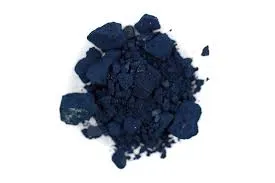How to Create Your Own Indigo Dye at Home for Creative Projects
The Art and Science of Making Indigo Dye
Indigo dye, known for its deep blue hue, has been cherished for centuries across various cultures for its vibrant color and enduring properties. The process of creating indigo dye is a fascinating blend of art and science, involving traditional methods and a profound understanding of nature’s chemistry. In this article, we will explore the steps to make indigo dye, the history behind its use, and why it continues to be relevant today.
Historical Context
The use of indigo dye dates back thousands of years, with evidence of its use found in ancient Egypt, India, and China. It became particularly significant during the Middle Ages when European traders brought it back from India, leading to its widespread adoption. Indigo was once so valuable that it was often referred to as blue gold. The dye is derived from plants such as Indigofera tinctoria, which contains compounds called indican. When processed correctly, these compounds yield the deep blue color that indigo is famous for.
Materials Needed
To make indigo dye at home, you will need several key materials 1. Indigo leaves (or powdered indigo) 2. Water 3. A reducing agent (like sodium hydrosulfite or fructose) 4. Lime or soda ash to alkalize the solution 5. A container for fermentation (preferably glass or ceramic) 6. Stirring implement
Step-by-Step Process
1. Preparation of Indigo Leaves If you are starting with fresh indigo leaves, the first step is to harvest and prepare them. Remove the leaves from the stem and rinse them to remove any dirt or impurities.
2. Fermentation Fill a container with water and add the harvested indigo leaves. Stir the mixture to release the indigo molecules. Cover the container and let it sit for about 24 hours at a warm temperature. This fermentation process allows the indican to break down into indigo.
make indigo dye product

3. Creating the Dye Bath After fermentation, strain the mixture to remove the leaves, leaving behind a liquid that contains soluble indigo. This liquid needs to be alkaline; thus, you should add lime or soda ash. The pH level is crucial, as it allows the color to develop more effectively.
4. Reducing the Indigo To create the dye bath, add a reducing agent to the liquid. This will help convert the insoluble indigo into a soluble form. Stir thoroughly and allow it to sit for an additional 30 minutes. The liquid will turn a yellowish-green, indicating that indigo is now in its reduced state.
5. Dyeing Process Pre-soak the fabric you wish to dye in warm water, then dip it into the indigo dye bath. The fabric will initially appear green; however, as it is exposed to air, it will oxidize and turn blue. Repeat the dipping process until you achieve your desired shade.
6. Rinse and Dry After dyeing, rinse the fabric in cool water to remove excess dye. Allow it to dry in a shaded area to avoid direct sunlight, which can fade the color.
Modern Relevance
Indigo dye has experienced a resurgence in recent years, fueled by a growing interest in sustainable fashion and natural dyeing methods. As consumers become more conscious of the environmental impacts of synthetic dyes, the appeal of indigo, made from natural sources, grows stronger. Artisans and designers are exploring the traditional methods of dyeing, creating unique fabrics and garments that carry history and culture.
Additionally, indigo dyeing workshops and classes have become popular, allowing individuals to connect with the craft and learn about textile traditions. This revival not only honors the heritage of indigo dye but also fosters a community of makers dedicated to sustainable practices.
Conclusion
Making indigo dye is more than just a technique; it is a journey through history and culture. By understanding and practicing this craft, we not only keep ancient traditions alive but also embrace a sustainable future. Whether you are a hobbyist, an artist, or simply curious about the process, making indigo dye is a rewarding experience that can brighten both your fabrics and your knowledge of natural dyeing methods.
-
The Timeless Art of Denim Indigo Dye
NewsJul.01,2025
-
The Rise of Sulfur Dyed Denim
NewsJul.01,2025
-
The Rich Revival of the Best Indigo Dye
NewsJul.01,2025
-
The Enduring Strength of Sulphur Black
NewsJul.01,2025
-
The Ancient Art of Chinese Indigo Dye
NewsJul.01,2025
-
Industry Power of Indigo
NewsJul.01,2025
-
Black Sulfur is Leading the Next Wave
NewsJul.01,2025

Sulphur Black
1.Name: sulphur black; Sulfur Black; Sulphur Black 1;
2.Structure formula:
3.Molecule formula: C6H4N2O5
4.CAS No.: 1326-82-5
5.HS code: 32041911
6.Product specification:Appearance:black phosphorus flakes; black liquid

Bromo Indigo; Vat Bromo-Indigo; C.I.Vat Blue 5
1.Name: Bromo indigo; Vat bromo-indigo; C.I.Vat blue 5;
2.Structure formula:
3.Molecule formula: C16H6Br4N2O2
4.CAS No.: 2475-31-2
5.HS code: 3204151000 6.Major usage and instruction: Be mainly used to dye cotton fabrics.

Indigo Blue Vat Blue
1.Name: indigo blue,vat blue 1,
2.Structure formula:
3.Molecule formula: C16H10N2O2
4.. CAS No.: 482-89-3
5.Molecule weight: 262.62
6.HS code: 3204151000
7.Major usage and instruction: Be mainly used to dye cotton fabrics.

